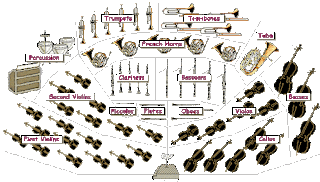People are born with built —in musical instruments— their voice boxes. But not even our very early ancestors were satisfied with having just their voices to make music. Thousands of years ago they learned to make musical instruments out of reeds, hollow logs, and other things they found around them.
The image on this page show some of the many kinds of musical instruments. Some kinds of instruments have been played since ancient times. Others have been developed in recent times.
Most musical instruments belong in one or another of these three groups: wind instruments, stringed instruments, and percussion instruments. In every musical instrument there must be something which can be set to moving back and forth, or vibrating. Unless something is vibrating, no sound comes from the instrument.
Wind instruments are all played by setting the air inside them to vibrating. As a rule the player blows into them. Their name tells that stringed instruments have strings. The player plucks the strings with his fingers or draws a bow across them. Percussion instruments are played by striking them. It is easy to sort out most of the instruments in the image (below) into their proper places in these three groups.
There are a few instruments that do not fit exactly into any one of these groups. The piano is a good example. It has many strings, but it is played by making little felt hammers hit the strings. Thus it is both a percussion and a stringed instrument.
In bands only wind and percussion instruments are used. Orchestras use stringed instruments, too.
